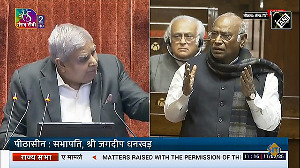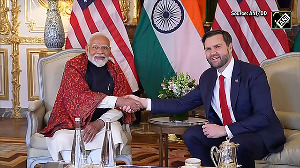I frankly cannot figure out the frenzied excitement of the commentariat (the new buzz word denoting the entire community of commentators) every time the Reserve Bank of India Governor, Dr Y V Reddy, periodically busies himself with the limited repertoire of rates -- repo, cash reserve ratio, statutory liquidity ratio -- at his disposal.
For instance, a Wharton College paper says, "For a banker who is supposed to make his moves sedately and soberly, Reddy has always surprised the market. Whether it is the size of hikes or their timing, the RBI Governor has habitually done the unexpected."
This is a bit of overplaying for effect. Dr Reddy has always had a penchant for doing the expected and has never sprung a surprise. In fact, even in the second half of 2006-07 itself, he raised the main lending rate five times and increased the CRR three times to drain liquidity from the system.
There are confident assertions by observers of another hike before the year ends. A research report by Merrill Lynch, prepared after the most recent hikes loftily proclaims: "Expect 75 bps CRR and 50 bps repo rate hike by the RBI in the second half of 2008-09." The Citigroup expects the RBI "to maintain its tightening stance using a combination of repo and CRR hikes."
Actually, to me, the RBI looks like a maestro who has a piano with only three keys to play upon, and who, for all it is worth, keeps pounding them, producing only loud clanging noises and no music.
Ever since the rate of inflation started climbing in February, Dr Reddy has been notching up those rates by assorted slabs of basis points (the glamorous present-day coinage looking numerically more impressive than old time percentage equivalents) to halt the march of inflation.
For all the convoluted explanations accompanying every such grand performance to full audiences in the cavernous hall of the soaring RBI building in Mumbai, inflation is proving to be unstoppable and has now crossed the dreaded double digit and threatens to move further North.
Perturbing phenomenon
It is not as if the government's repertoire of counter-measures was any better. It banned exports of a few items, reduced customs and excise duties on a few others, twisted the arms of producers of cement and steel and such, but could only be said to have ultimately reached a dead end.
Inflation is a perturbing phenomenon for any country at any time, but in the special context of India at this time, it is giving sleepless nights to both the RBI and the government. Indeed, the very mention of it is generating something akin to panic. The most obvious cause is the looming election to the Lok Sabha within the next six months or so.
As if getting mired in the cash-for-votes scandal is not enough, the United Progressive Alliance coalition government has suffered a severe erosion of its credibility over the dilatory and inept handling of the conflagration in Jammu and Kashmir in respect of land allotment for the Amarnath Shrine Board, its totally confused and contradictory positions on the Sethu Samudram project, the fearful prospect of losing large mass of Hindu votes on that account, particularly in the Northern States, and its ineffectiveness in combating terrorism.
The last is a particularly damaging and sensitive one in view of the series of bomb blasts carried out from last November onwards by the so-called Indian Mujahideen which apparently has developed the capacity to strike at will when and where it pleases.
The leadership and membership of this new monster is still a mystery to the government's security and intelligence machinery. In these circumstances, it is natural for the government to want to guard against inflation becoming a lethal electoral weapon in the hands of its opponents.
That is why both the RBI and the government are at such pains to assuage the people with their own projections and predictions, not worrying about their going wrong time after time.
Definitive but dubious
At least, Finance Minister, P Chidambaram, being a political animal, and with election round the corner, has an excuse for putting a gloss on the real state of affairs hoping on the shortness of public memory. But the RBI, as a professional and expert body, ought to make sure that its prognosis is sustainable.
Contrary to this premise, the RBI has been sticking its neck out with definitive, if dubious, scenarios. As regards 2008-09, "Growth should be 8 percent," Dr Reddy has said, adding, "This is below 8.5 per cent" (that is obvious enough, Sir!) "but, compared to the drop in growth rates all over the world or our standards, it will be a very, very marginal moderation." What is the precise connotation of words such as 'should be,' 'very, very' and 'marginal'?
Or, let us take this statement which he made at the time of the latest revision of rates: "Our internal analysis indicates that barring any further shocks, particularly globally, headline inflation for the next few months will be around current levels. From the second half of the third quarter it will start moderating, and by the fourth quarter we are confident we will bring it down to seven per cent."
This is not such a profound conclusion as to need the whole paraphernalia of the RBI's internal analysis. However, one hopes that unlike similar assertions of the past, at least these will hold good when the time comes.
Apparently, the government is in tacit agreement with the RBI in giving a higher priority to inflation control in the current context, keeping the next year's general election in mind, even if it affects economic growth.
But should inflation-control necessarily have the effect of decelerating growth, as conventional wisdom would have it? Is it possible to put curbs on inflation without affecting growth and indeed, while continuing to stimulate growth?
The question needs to be looked afresh with an open mind not, perhaps, by academics and scholars who have no hands-on experience in running business and commercial enterprises, but by in-house policy planners who are also practised in decision-making in the face of challenges.
Flush with funds
To lay down the same economic outcome or prescription as being applicable to all countries regardless of their special endowments and prospects on the face of it flies against common sense.
India Inc is coming into its own as a trigger of economic development in its own right, with the capacity to absorb the impact of external environment, including the doings of the governments. There is a lot of space yet available for rising to their full potential in terms of increasing the volume, velocity, variety and versatility of economic transactions.
Interestingly, the Wharton College paper refers to a study bringing to light the fact that even as of now corporate India is flush with funds thanks to past three years of bumper profits.
The cumulative cash position in 2007-08 of 758 private sector firms stood at more than $23.5 billion, up from $17.7 billion in 2006-07. The figures for 2007-08 of another 500-odd firms was not available, but they had a cash balance of $36 billion in 2006-07. In other words, all these companies will comfortably meet the growth requirements during 2008-09 and beyond.
In short, if India Inc lives up to the expectations in the required measure of resilience, innovation, initiative, imagination and leadership, it can help harmonise the imperatives of growth with control of inflation.
They need not be in conflict with each other and may well run in parallel streams, one under the watchfulness of the government and the other under that of India Inc.






 © 2025
© 2025